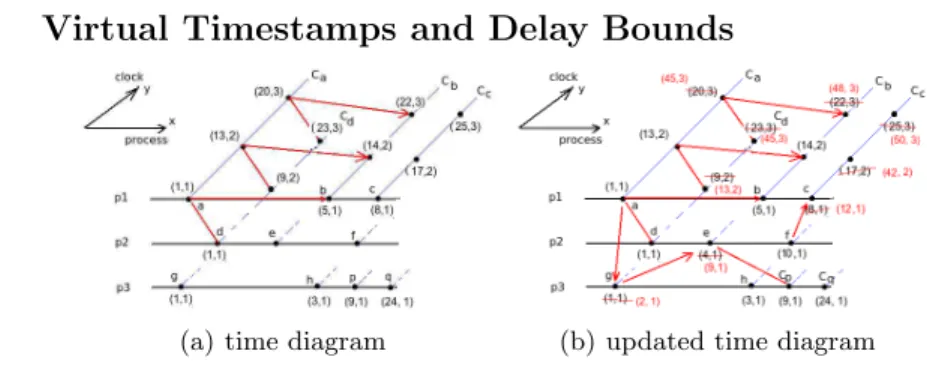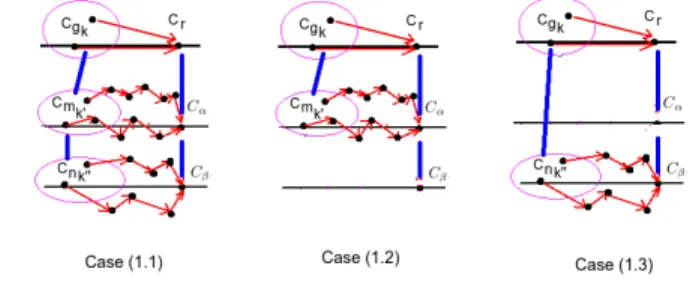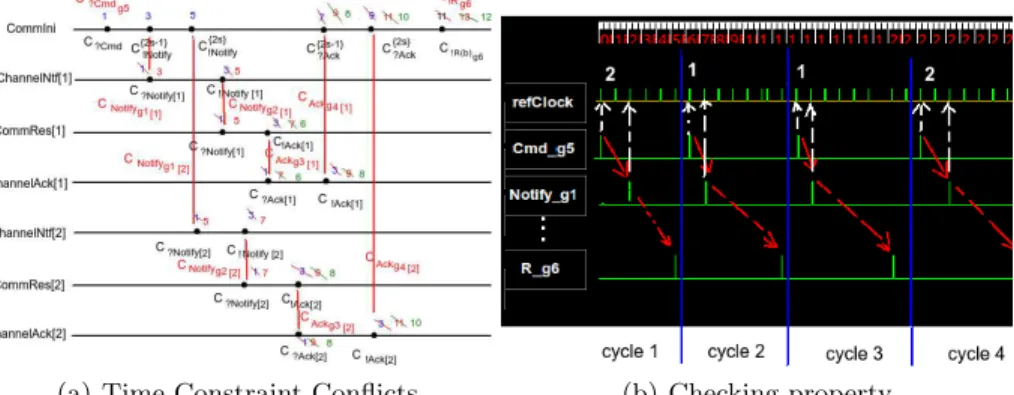HAL Id: hal-01097783
https://hal.inria.fr/hal-01097783
Submitted on 22 Dec 2014
HAL is a multi-disciplinary open access
archive for the deposit and dissemination of
sci-entific research documents, whether they are
pub-lished or not. The documents may come from
teaching and research institutions in France or
abroad, or from public or private research centers.
L’archive ouverte pluridisciplinaire HAL, est
destinée au dépôt et à la diffusion de documents
scientifiques de niveau recherche, publiés ou non,
émanant des établissements d’enseignement et de
recherche français ou étrangers, des laboratoires
publics ou privés.
Investigation on Time Properties of Timed-pNets
Yanwen Chen, Yixiang Chen, Eric Madelaine
To cite this version:
Yanwen Chen, Yixiang Chen, Eric Madelaine. Investigation on Time Properties of Timed-pNets.
National Software Application Conference, Nov 2014, Guilin, China. �hal-01097783�
Investigation on Time Properties of
Timed-pNets
Yanwen CHEN1,2,3, Yixiang CHEN1, Eric MADELAINE2,3 ⋆
1 MoE Engineering Research Center for Software/Hardware Co-design Technology
and Application,
East China Normal University, 200062, Shanghai, China
2 INRIA Sophia Antipolis M´edit´erann´ee, BP 93, 06902 Sophia Antipolis, France,
3 University of Nice Sophia Antipolis, CNRS, UMR 7271, 06900 Sophia Antipolis,
France
Abstract. Timed-pNets is a semantic model to specify the
communi-cation behaviours of distributed systems. It has a tree style hierarchical structure. The leaves are timed specifications which consist of a set of logical clocks and clock relations. These logical clocks are encoded with delay variables and delay bound. In this paper we discuss how to detect time constraint conflicts and how to compute delay variables of clocks in the non-leaf nodes. Then we can check system’s time properties like deadline. From our formalization of timed-pNets, we generate a system of logical clocks that can be simulated in the TimeSquare tool. We take a simple use case from ITS to simulate and check some time properties.
1
Introduction
Timed-pNets[3] has been proposed to specify communication behaviours of het-erogeneous distributed systems. This timed model is able to specify time con-strains based on logical time. Logical time has proved its benefits in several domains. It was first introduced by Lamport to represent the execution of dis-tributed systems [5]. Logical time can be multiform, a global partial order built from local total orders of clocks. The multiform nature of logical time consists in the ability to use any repetitive event as a reference for the other ones[2]. In-spired by the CCSL [1], we design clock relations to express the systems logical time constraints. So our model is a logical constraint model that is expressed by a set of logical clocks and clock constraints.
However, the logical constraint model cannot be directly used to check some time properties like deadline property since the distance of two clocks cannot be measured. In this paper, we focus on address the issue of transferring our logical constraints model to schedulable model in which the time properties like deadline can be checked. We propose a virtual timestamp to link those logical clocks. In Lamport, virtual time is identifiable by the succession of events (and therefore is
⋆This work was funded by DAESD of INRIA and ECNU; by NSFC (No. 61321064
discrete). It does not flow by its own means like real time whose passage we can not escape or influence. Based on his work, we define our virtual timestamp as two dimension values, and the number we assign to clocks as virtual timestamp is based on a reference clock. By this way, we can compare the delay variables from different logical clocks. Furthermore, we propose a theorems about computing delay variable of global clocks in timed-pNets. In the end, we take a use case from ITS (Intelligent Transportation Systems) for simulation.
2
Virtual Timestamps and Delay Bounds
(a) time diagram (b) updated time diagram
Fig. 1: Time Diagram and Updated One
We define a virtual timestamp as a pair of natural numbers: one represents when a timed-action occurs in terms of a reference clock (X-axis), another repre-sents the order of the occurrences of a timed-action (Y-axis). Fig.1 shows us an example in which the timed-actions are assigned with virtual timestamps. In the figure, the processes are presented as solid black lines. The sequence of timed-actions executed in these processes are presented as solid black points on these black lines. The actions in each process are totally ordered. The communications between processes are represented by clock relations. For example, in the Fig. 1, the clock Ca and clock Cd are coincident. We use a sequence of red lines to
represent the coincidence relation of two clocks. Similarly, we use a sequence of red arrows to represent the precedence relations (e.g. Ca ≺ Cb). We define the
virtual timestamps and their assignment rules as follows.
Definition 1 (Virtual Timestamps). A virtual timestamp (denoted as T (α i))
of a timed-action occurrence α i is a pair of natural numbers (xα i, i) (xα i ∈
N, i∈ N).
Definition 2 (Virtual Timestamp Assignment Rules). Let T (α i), (xα i, i)
be the virtual timestamp of the occurrence α i of the clock Cα(α ∈ LA,T ,P), and
T(β i), (xβ i, i) be the virtual timestamp of the occurrence β i of the clock Cβ
(β ∈ LA,T ,P). Then we have:
– Cα= Cβ ⇒ ∀i, xα i= xβ i:= max(xβ i, xα i)
– Cα ≺ Cβ ⇒ ∀i, xα i < xβ i and xβ i := max(xα i, xβ i) + tβi (the variable
tβi presents the delay time from the occurrence α i to β i in terms of the
Initially, for an independent clock (without any relation with other clocks), the X-axis value of the timestamps of the clock can be set with any natural number. The values will be updated according to the clock relations applied on this clock. Take the clock Cbin the Fig. 1(a) as an example, we know the relation
Ca ≺ Cb≺ Cc. According to the assignment rules, we must have xa1 < xb1<
xc1. In this figure, the timestampe of the first occurrence of clock Cb is initially
set as (5, 1). It can also be initially set as (7, 1) only if it satisfied the condition xa1 < xb1 < xc1. When adding new clock constraints, these timestamps in
the Fig.1 may also be updated according to the assignment rules. For example, assume that we add other four clock relations (Ca≺ Cg, Cg≺ Ce, Cf ≺ Cc, Ce=
Cp). If the delay from Cfto Ccis 2, then the virtual timestamps may be updated
by following the rules (as shown in the Fig.1(b)). 2.1 Time Constraint Conflicts
Since the timestamps may be updated, the clock delays may also be updated, which may cause time constraint conflicts. For example, in the Fig. 1, assume the delay bound of Cc is [2, 5]. Before we add the relation Cf ≺ Cc, there is no
time constraint conflict since tCc[1] = 8 − 5 = 3 ∈ [2, 5]. However, after adding
this relation, we found out that tCc[1]= 12 − 5 = 7 6∈ [2, 5]. Here we give a formal
definition of time constraint conflicts.
Definition 3 (Time Constraints conflicts). Let Cαbe a clock built on
timed-action α(p)tα|btα. A time constraint conflict of clock C
α exists if ∃i ∈ N, tαi 6∈
btαi.
Fig. 2: Three cases in Theorem 1 2.2 Compute Delay and Delay Bounds
In timed-pNets, non-leaf nodes are the synchronization devices of their subsys-tems. The delays and delay bounds of the global logical clocks in these non-leaf nodes are computed in terms of the local logical clocks of the subsystems. When building these non-leaf nodes, time constraint conflicts may happen. Here, we propose a theorem to compute the delays and delay bounds of these global clocks so that we can check if time constraint conflicts exist.
Theorem 1 (The Delay Bounds of Global Clocks). Given a timed-pNet < P, AG, CG, J, eAJ, eCJ, eRJ,
− →
have no time constraint conflict. Consider a global clock Cγ and let Cg= {Cgk}(k ∈
N) be the set of causal clocks of Cγ (Cg⊆ CG, Cγ ∈ CG, γ, γ(pγ)tγ|btγ).
(1) When −→v =< ..., Cα, ..., Cβ, ... >→ Cγ. As shown in Fig. 2, let Cm =
{Cmk′}(k
′ ∈ N) be a set of local clocks that are in the same hole as C α,
and that contribute to generate the global clocks in Cg. Let Cn= {Cnk′′} be
a set of local clocks that are in the same hole as Cβ, and that contribute to
generate the global clocks also in Cg.
(1.1) If < . . . , Cmk′, . . . , Cnk′′, . . . >→ Cgk as shown the case (1.1) in Fig. 2,
then bCγ = [min{min{l(bPCm k′→Cα)|k ′ ∈ N}, min{l(b PCn k′′→Cβ)|k ′′∈ N}}, max{max{u(bPCmk′→Cα)|k ′ ∈ N}, max{u(b PCnk′′→Cβ)|k ′′∈ N}}] (C mk′ ∈ Cm, Cn k′′ ∈ Cn, k ′, k′′∈ N);
(1.2) If < . . . , Cmk′, . . . , . . . , . . . >→ Cgk as shown the case (1.2) in Fig. 2,
then bCγ = [min{l(bPCm k′→Cα)|k ′∈ N}, max{u(b PCm k′→Cα)|k ′∈ N}] (C mk′ ∈ Cm, k′∈ N),
(1.3) If < . . . , . . . , . . . , Cnk′′, . . . >→ Cgk as shown the case (1.3) in Fig. 2,
then bCγ = [min{l(bPCnk′′→Cβ)|k ′′∈ N}, max{u(b PCnk′′→Cβ)|k ′′∈ N}] (C nk′′ ∈ Cn, k′′∈ N),
(2) When −→v =< ..., Cα, ..., . . . , ... >→ Cγ. Let Cm be a set of local clocks that
in the same hole as Cα, and that contribute to generate the global clocks
in Cg.Then bCγ = [min{l(bPCmk′→Cα)|k ′ ∈ N}, max{u(b PCmk′→Cα)|k ′ ∈ N}] (Cmk′ ∈ Cm, k ′∈ N).
Because of the page limitation, we omit the proof. In the theorem, l(bPCmk′→Cα)
(resp.u(bPCm
k′→Cα)) means the lower (resp. upper) bound of bPCmk′→Cα from
clock Cmk′ to clock Cα along a set of paths.
3
Simulation
C ?Cmd(Ins)tc C !Notify(Ins,k)tn [k = 1; k++; k C τtτ ?Ack(k,r ) C mta C !R(b)tR b=V rm CommIni 2] [k = 1; k++; k 2] C ?Notify(Ins)tn !Ack(r ) C mta CommRes[m] [m] [m] ChannelNtf[m] ChannelAck[m] C c.?Notify(Ins,k)tn [m] C c.!Notify(Ins,k)tn[m] C c.?Ack(r )mta[m] C c.!Ack(r )mta[m] C !R(b) g6 C ?Cmdg5 Notify g1 C C Notify g2 Ack g3 C Ack g4 C [m] [m] [m] [m] Timed-pNetsFig. 3: Example of a Timed-pNets subsystem
We simulate the system of the Fig. 3 by means of the TimeSquare tool [4] to check system time constraint conflicts. For simplification, we choose a reference clock that ticks periodically. All delays and delay bounds of other logical clocks are specified in terms of this reference clock. In our simulation, we assume that
the delay bounds of all action occurrences are between [1, 3] in the sense that the delays of those actions should stay between the first and the third occurrences of the reference clock. The simulation result tells us if conflicts exist in the system.
Result: TimeSquare reports us an error. The main reason is that the
commu-nications between those component create conflicts. By analyzing those updated virtual timestamps in the Fig.4(a), we can see that a time constraint conflict happens on the clock C?Ack{2s−1} (xC{2s−1}
?ack [1]− xC {2s}
!notif y[1]= 9 − 5 = 4 6∈ [1, 3]).
Solution: To fix the issue, we set the delay of ?N otif y i in component
“CommRes” to 1 and limit the delays of all clocks less than 2 except the clock C?Ack{2s−1}. After redoing the simulation, we found out that no conflict exists. TimeSquare outputs VCD view as shown in Fig.4(b).
(a) Time Constraint Conflicts (b) Checking property
Fig. 4: Conflict Analysis and Results
4
Conclusion
In this paper, we investigated the time constraints and properties of timed-pNets model. We took a use case from ITS to build a timed-pNets communication model. From our formalization of timed-pNets, we generated a system of logical clocks and solved the issue of detecting time constraint conflicts.
References
1. Charles Andr´e. Syntax and Semantics of the Clock Constraint Specification Lan-guage (CCSL). Rapport de recherche RR-6925, INRIA, 2009.
2. Fr´ed´eric Boussinot and Robert De Simone. The esterel language. Proceedings of the IEEE, 79(9):1293–1304, 1991.
3. Yanwen Chen, Yixiang Chen, and Eric Madelaine. Timed-pNets: A formal communi-cation behavior model for distributed systems. In Journal of Frointier of Computer Science, 2014.
4. Julien Deantoni and Fr´ed´eric Mallet. TimeSquare: Treat your Models with Logical Time. volume 7304 of Lecture Notes in Computer Science - LNCS, pages 34–41, Prague, Tch`eque, R´epublique, May 2012. Springer.
5. Leslie Lamport. Time, clocks, and the ordering of events in a distributed system. Communications of the ACM, 21(7):558–565, 1978.



